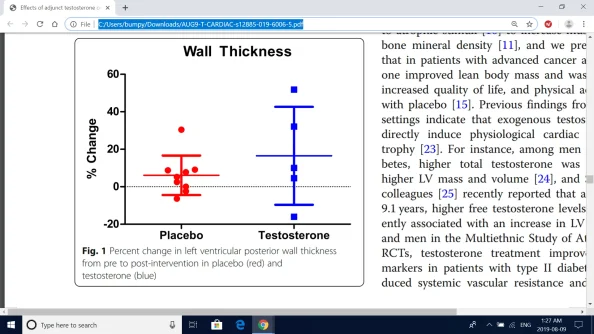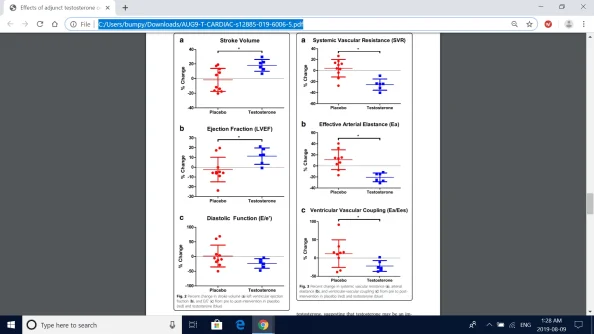madman
Super Moderator
Effects of adjunct testosterone on cardiac morphology and function in advanced cancers: an ancillary analysis of a randomized controlled trial
Background: Adjunct testosterone therapy improves lean body mass, quality of life, and physical activity in patients with advanced cancers; however, the effects of testosterone on cardiac morphology and function are unknown. Accordingly, as an ancillary analysis of a randomized, placebo-controlled trial investigating the efficacy of testosterone supplementation on body composition in men and women with advanced cancers, we explored whether testosterone supplementation could prevent or reverse left ventricular (LV) atrophy and dysfunction.
Methods: Men and women recently diagnosed with late stage (≥IIB) or recurrent head and neck or cervical cancer who were scheduled to receive standard of care chemotherapy or concurrent chemoradiation were administered an adjunct 7 week treatment of weekly intramuscular injections of either 100 mg testosterone (T, n = 1 M/5F) or placebo (P, n = 6 M/4F) in a double-blinded randomized fashion. LV morphology (wall thickness), systolic function (ejection fraction, EF), diastolic function (E/A; E’/E), arterial elastance (Ea), end-systolic elastance (Ees), and ventriculararterial coupling (Ea/Ees) were assessed.
Results: No significant differences were observed in LV posterior wall thickness in placebo (pre: 1.10 ± 0.1 cm; post: 1.16 ± 0.2 cm; p = 0.11) or testosterone groups (pre: 0.99 ± 0.1 cm; post: 1.14 ± 0.20 cm; p = 0.22). Compared with placebo, testosterone significantly improved LVEF (placebo: − 1.8 ± 4.3%; testosterone: + 6.2 ± 4.3%; p < 0.05), Ea (placebo: 0.0 ± 0.2 mmHg/mL; testosterone: − 0.3 ± 0.2 mmHg/mL; p < 0.05), and Ea/Ees (placebo: 0.0 ± 0.1; testosterone: − 0.2 ± 0.1; p < 0.05).
Conclusions: In patients with advanced cancers, testosterone was associated with favorable changes in left ventricular systolic function, arterial elastance, and ventricular-arterial coupling. Given the small sample size, the promising multisystem benefits of testosterone warrants further evaluation in a definitive randomized trial.
Background: Adjunct testosterone therapy improves lean body mass, quality of life, and physical activity in patients with advanced cancers; however, the effects of testosterone on cardiac morphology and function are unknown. Accordingly, as an ancillary analysis of a randomized, placebo-controlled trial investigating the efficacy of testosterone supplementation on body composition in men and women with advanced cancers, we explored whether testosterone supplementation could prevent or reverse left ventricular (LV) atrophy and dysfunction.
Methods: Men and women recently diagnosed with late stage (≥IIB) or recurrent head and neck or cervical cancer who were scheduled to receive standard of care chemotherapy or concurrent chemoradiation were administered an adjunct 7 week treatment of weekly intramuscular injections of either 100 mg testosterone (T, n = 1 M/5F) or placebo (P, n = 6 M/4F) in a double-blinded randomized fashion. LV morphology (wall thickness), systolic function (ejection fraction, EF), diastolic function (E/A; E’/E), arterial elastance (Ea), end-systolic elastance (Ees), and ventriculararterial coupling (Ea/Ees) were assessed.
Results: No significant differences were observed in LV posterior wall thickness in placebo (pre: 1.10 ± 0.1 cm; post: 1.16 ± 0.2 cm; p = 0.11) or testosterone groups (pre: 0.99 ± 0.1 cm; post: 1.14 ± 0.20 cm; p = 0.22). Compared with placebo, testosterone significantly improved LVEF (placebo: − 1.8 ± 4.3%; testosterone: + 6.2 ± 4.3%; p < 0.05), Ea (placebo: 0.0 ± 0.2 mmHg/mL; testosterone: − 0.3 ± 0.2 mmHg/mL; p < 0.05), and Ea/Ees (placebo: 0.0 ± 0.1; testosterone: − 0.2 ± 0.1; p < 0.05).
Conclusions: In patients with advanced cancers, testosterone was associated with favorable changes in left ventricular systolic function, arterial elastance, and ventricular-arterial coupling. Given the small sample size, the promising multisystem benefits of testosterone warrants further evaluation in a definitive randomized trial.
Attachments
Last edited:













